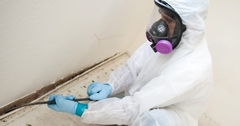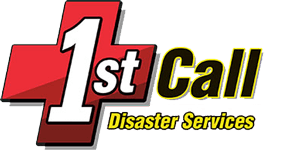Blog Post
All About Mold Series – #4 A Detailed Look at Mold Remediation

It is always a good idea to involve a professional when an area of the home persistently experiences elevated moisture levels indicated by precipitous discoloration generally believed to be mold growth? Even if the visible area is less than 10 square feet (roughly 3'x 3') there can be more contaminants in non-viewable wall cavities, etc. Does it matter what kind of mold it is? Does it matter if it is toxic or not? Yes and no…IF the growth is persistent there are underlying issues and whatever species of mold it is, it likes that area and has all it needs to propagate. Yes, a professional inspection is advised because what KIND of mold it is, to some degree, is irrelevant because it is continuing to grow. A professional can determine appropriate next-steps not only to rid of the mold but more thoroughly address the moisture intrusion issue. Often an individual is coached by our company on how to remove small amounts of mold properly and then asked to watch the area for a period of time. IF the growth persist by returning a short time later, then ridding of the growth will likely require a level of professional attention. It is advisable to always where a mask (N-95 at a minimum) during the cleaning as a particular mold spore type may, in fact, irritate your body. IF this begins to happen stop immediately and call 1st Call Disaster Services to assess the situation to a more detailed level.
Mold Remediation Overview
Below are steps to follow for the mold remediation process…
- Wear protective clothing/equipment
- Contain and manage the spread of mold spores with containment
- Use of engineered environmental controls
- Physical removal and cleaning of grossly contaminated material
- Proper cleaning of ALL surfaces within the contained area
- Likely cleaning of all of the duct work and HVAC system (this is most often necessary, but MAY not be)
- Treatment of materials to prevent growth until the materials are to an acceptable dry standard
- Drying of materials to prevent future growth
- When appropriate – air sampling
Protective Equipment for Mold Remediation
Professionals wear protective clothing and use proper equipment while performing mold remediation as this is when the mold spores are most likely to become airborne.
Protective equipment for mold remediation includes…
- Dust filter mask or respirator (N-95 minimum)
- Goggles
- Gloves
- Protective clothing that covers entire body
Containing Mold Spores
When professionals remove significant molded materials, the affected areas will be sealed off to prevent mold spores from spreading to other areas of the home or business. Use of plastic sheeting will be utilized to cover doorways, vents and any other openings.
Use Negative Pressure
Professionals sometimes use negative pressure in the room they are cleaning. This is accomplished by directing exhaust out of an opening or door to move air outside of the home/building while also providing filtered replacement air to the containment. Mold spores that are disturbed and become airborne during the removal process can then be forced outside. Air conditioning systems in the home/building are turned off prior to beginning the mold removal process so as not to distribute the spores throughout.
Removing the Mold
During mold removal is when mold spores are likely to become airborne. Professionals utilize various methods to minimize this issue. The objective is to capture spores, contain them and remove them to the out of doors. Minimizing the movement of these spores while work is being conducted is one of the goals although it will never be a perfect process and that is the reason for engineered containment controls.
Prevent Future Mold
The key to preventing mold growth is the absence of moisture or at a minimum managing the environment for proper levels of moisture. Anytime a mold remediation process is being administered, ALL surfaces in the containment must be properly cleaned, treated and dried (if applicable). To be quite blunt one must be able or comfortable licking off of ANY surface in that containment.
Cleaning Belongings and Materials
Non-porous or many semi-porous materials such as glass, metal, plastics and wood surfaces can be used again after professionals have completely cleaned the mold from all surfaces. However, porous materials like drywall, carpet, books and soft furnishings MAY not be salvageable depending upon the level of contamination. A professional can help one determine between cleanable/non-cleanable, salvageable/non-salvable materials and goods.
HEPA Vacuuming
A large and critical part of the process involves capturing the mold spores in such a way that micro-levels of clean filtering is achieved. ALL surfaces must be vacuumed the same way the ALL must be cleaned an treated to achieve satisfactory results in a Post Remediation Evaluation air sampling test. This practice may be applied several times during the process to achieve acceptable level of debris removal. A normal consumer grade vacuum will not suffice for this duty.
Mold Disposal
The ultimate goal, as has been stated in earlier publications on our website, is to bring a building into a level of normalcy categorically classified as a home/business "having a condition 1 fungal ecology." In layman's terms it simply means that mold is EVERYWHERE and cannot be escaped on a permanent basis. Thus, the primary focus of mold remediation is to capture the mold spores and take them outside the structure/containment. The goal is not to KILL the spores.
Think of it this way – if someone came into your home and killed and animal but left the body in the home. Terribly gross right! Mold is a living organism so killing it is not the objective, else a decomposing organism remains in the area to give off mycotoxins. All procedures above seek to properly address the source and remove it from the area.
One final note: The phrase, "I'm allergic to mold" is largely an illegitimate statement as there are over 100,000 species of identified mold. So to determine which one is bothering an individual can only be determined by a medical professional. Our goal at 1st Call Disaster Services is to focus on the proper removal of ANY type of mold…whether is has the potential to cause bodily harm or not.
1st Call Disaster Services specializes in eliminating mold issues and providing preventative measures to address areas of moisture intrusion.
A good restoration company can make sure a mold remediation is done right and that you're out of pocket damage liability is kept to a minimum. We've helped numerous home and business owners and they and their insurance company always appreciate our surgical approach to restoration!
Contact Us (812) 220-3385 for a consultation.
All About Mold Series
- All About Mold Series - #7 When and Why to Test for Mold
- All About Mold Series - #6 What Happens and What to Expect During a Mold Inspection
- All About Mold Series - #5 Signs That You May Have Mold In Your House
- All About Mold Series - #4 A Detailed Look at Mold Remediation
- All About Mold Series - #3 The Health Effects of Mold
- All About Mold Series - #2 Detecting and Removing Mold. Can Mold Make Me Sick?
- All About Mold Series - #1 Understanding How Mold Thrives Can Help Us Prevent Mold Growth In Your Home or Business
